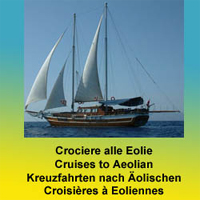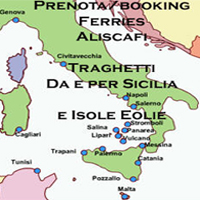HISTORY
 History
History
The Aeolian islands were populated at the beginning of the fourth millennium BC from people coming from Sicily, pushed from the immense economic resource offering from obsidian erupted from the volcano of Mount Pelato.
The obsidian, a volcanic glass cutting black, was sought when they had spread the metalworking and formed the basis for the prosperity enjoyed in the islands for at least two millennia.
After a few centuries of decadence Aeolian islands had an economic and civil revival in the age of bronze in the eighteenth century. BC
This awakening is due to contacts that were to have with the principalities of Mycenaean Greece which explored the western seas.
The islands were frequented by people micenee of aeolian lineage rooted in Metaponto. From these aeolian people the islands took the name that still retain. They brought the legends of the mythical King Aeolus, Lord of the winds.
During the thirteenth century. BC settled in the islands, from the coast of Campania, people ausonie with which connects the legend of King Liparo, which drew the city name. Spopolate the end of the tenth century. BC the islands remained deserted for a few centuries.
In The L Olympics (580-576 BC) Lipari was colonized by a group of Greek Doric race, Cnidus and Rhodes, the new settlers found themselves obliged to defend themselves from the incursions of the Etruscans. They had set up a powerful fleet with which reported big victories ensuring the supremacy of the sea. With the booty was erected in the sanctuary of Apollo, Delphi, votive splendid monuments.
In 427 BC During the first Athenian expedition to Sicily the Lipari people tightened alliance with Syracuse. They were attacked by the Athenian and from Reggio Calabria fleet, but without serious consequences.
In shipping Carthaginian of 408-406 Lipari was again in friendly relations with Syracuse. It was therefore attacked by general Carthaginian Imilcone; parties Carthaginians, Lipari returned in full enjoyment of its independence.
During the domination of Dionysius the Elder, Lipari remained alongside Syracuse and Tindari. In 304 the island was attacked by Agatocle; Lipari subsequently fell under the yoke Carthaginian when the First Punic War.
For its excellent ports and its position high strategic value, the archipelago became one of the best naval stations Carthaginians.
In 262 the Roman consul Cornelius Scipio, deceiving themselves that they can conquer Lipari, was stopped and arrested by Hannibal.
In 258 Lipari was besieged from Atilio Calatino .
In 257 waters of the Aeolian islands were the scene of a fierce battle between the fleet Carthaginian and Roman. Lipari was conquered by the Romans in 252 BC destroyed lost with the independence economic prosperity. It began for a period of serious decline.
He continued to reap substantial economic benefits from dell’allume who extracted the island of Vulcano and Lipari which was in the ancient world monopoly.
Were frequented the hot springs of Vulcano and Lipari.
The Aeolian islands had a great strategic importance during the civil war between Octavian, master of Italy, and Sesto Pompeo, owner of Sicily. Lipari, fortified by Sesto Pompeo, was seized in 36 BC Agrippa, admiral of Octavian, who made the island of Vulcano the basis of its fleet for operations that preceded the naval battle of Milazzo and the subsequent landing in Sicily. Lipari new suffered devastation and new disasters.
We have no news about Lipari for the imperial Roman (I-IV sec. AD). During Christian (perhaps by the fourth century) Lipari was bishopric and at least since the sixth century were venerated in his cathedral of the relics of the St. Bartholomew, miraculously come from Armenia. In medieval centuries Lipari was a pilgrimage site. Around Aeolian islands flourishes in the early Middle Ages to harvest traditions.
Crater Volcano was considered to be the mouth of hell, where burned souls of sinners. Other legends flourish around the holy bishop Agatho and all’eremita S. Calogero that freed the island from devils and the water flow was healthy.
In the Middle Ages there was a sudden awakening of volcanic activity on the island of Lipari. Within the 839 Lipari was attacked and destroyed by a raid of Muslims who massacred and made slave people and was profaned the relics of St. Bartholomew.
Lipari remained for a few centuries almost totally deserted, until the reconquest of Sicily by the Normans, who in 1083 settled in Lipari Abbot Ambrose with a group of Benedictine monks. Around the monastery returned to form an urban core.
In 1131 it was reconstituted the bishopric of Lipari united to that of Patti. Roberto The king of Naples in 1340, conquered Lipari. In 1544 the city was sacked by Ariadeno fierce pirate Barbarossa, led by the inhabitants as slaves. Lipari was subsequently rebuilt and ripopolata by Charles V and since then followed the fate of Sicily and the kingdom of Naples.
GENERAL INFORMATIONS 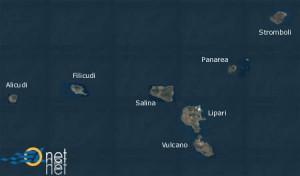 The Aeolian archipelago is made up of seven islands scattered, over 90 miles of sea along the north-west coast of Sicily in the Mediterranean Sea. The archipelago comprises several islands and seven major islands: Lipari, Salina, Vulcano, Stromboli, Panarea, Alicudi and Filicudi. The Aeolian represent the part emerged some volcanoes of geologically recent origin. This origin is evidenced by persistent volcanic phenomena, from hot springs submarine, from fumaroles of Lipari and Panarea, the mouths perennially active Stromboli and mud of great therapeutic effect.
The Aeolian archipelago is made up of seven islands scattered, over 90 miles of sea along the north-west coast of Sicily in the Mediterranean Sea. The archipelago comprises several islands and seven major islands: Lipari, Salina, Vulcano, Stromboli, Panarea, Alicudi and Filicudi. The Aeolian represent the part emerged some volcanoes of geologically recent origin. This origin is evidenced by persistent volcanic phenomena, from hot springs submarine, from fumaroles of Lipari and Panarea, the mouths perennially active Stromboli and mud of great therapeutic effect.
The oldest are Alicudi and Filicudi, which have about a million years. The younger ones are more active are Volcano and Stromboli. Happily located from a geographical point of view, the Lipari enjoy the mild and temperate climate typically Mediterranean. The islands are mainly rocky or sandy coast with high and steep, a vegetation of shrubs (heather, brooms), figs of india, trees, the climate is very mild but precipitation are very scarce and sources almost zero, so the drinking water, once collected in special tanks, is now essentially brought by boat from Sicily.
The rich in wildlife species: hawk, the bird of storms and the now extinct monk seal of Filicudi.
Tourism is now, thanks to rapid connections with hydrofoils and boats, the main resource of the islands today destinations bathing also very crowded (especially Lipari, Panarea and Salina; more secluded remain Alicudi and Filicudi, famous the latter for the cave suggestive of Bue Marino), which are much frequented by those who practice fishing. A much more modest role now have the traditional activities, such as viticulture, the extraction and processing of pumice stone, fishing, gathering of capers.
GEOLOGY OF AEOLIAN ISLANDS 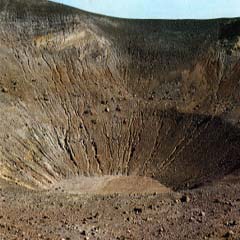 The Aeolian islands are volcanic islands active in the southern Tyrrhenian Sea. Among them are considered active volcanoes Stromboli, Lipari and Vulcano (with its Vulcanello peninsula).
The Aeolian islands are volcanic islands active in the southern Tyrrhenian Sea. Among them are considered active volcanoes Stromboli, Lipari and Vulcano (with its Vulcanello peninsula).
The activity of Stromboli consists of almost continuous explosions at very low energy, with the launch of magmatic waste from one of eruptive vents that are within the crater.
The last eruption of Volcano took place almost a century ago (1894).
The last eruption of Lipari took place in Roman times (from the point of view of the life of a volcano, the time elapsed since it is very short and not enough to consider the extinct volcanic activity on the island of Lipari).
During the Mesozoic Eastern Sicily was the one sporadic volcanism basico-alcalino relaxing followed by a period of stagnation.
During the era Quaternary can recognize two types of volcanism contemporaries:
- The basaltic volcanism relaxing (Etna, Iblei, Ustica, Canale di Sicilia).
- The volcanism convergence between the plates (Aeolian Islands).
The arch metamorphic is from arch crystal Calabro-Peloritano.
The Aeolian islands are facing the volcanic basin while the marginal retroarch is the abysmal level of the Tyrrhenian Sea. The continental crust is on both sides of the plate while contact is a ocean under the area of Tirreno abysmal.
The volcanism is the Archipelago of recent age (roughly 1 million years old) and can distinguish two phases.
During the first phase are formed islands of Alicudi, Filicudi, Panarea, in part, Lipari and Salina.
After a period of stagnation in the upper Pleistocene has a second phase with the completion of Lipari and Salina and the birth of Volcano and Stromboli. The Aeolian volcanism is marked by an evolution in the composition of products issued. The Aeolian Islands for their specific volcanism became in 2002 UNESCO cultural heritage of Humanity
THERMAL WATERS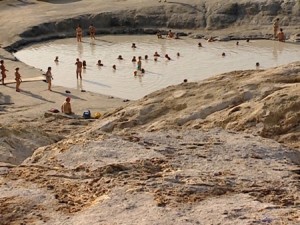
The archipelago Eoliano is center of attraction, not only for the variety of its natural beauty, but also for its hot springs high therapeutic value. These events postvulcaniche are found in Volcano, Lipari and Panarea.
So far the water and sludge, worked with systems primordial gave excellent results. In addition to the diseases of the joints, water and sludge Volcano can be very effective in many diseases like phlebitis, ulcers, female genital diseases and skin diseases.
For Vulcan, it is natural volcanic sludge high in radon and even hot springs the criterion of choice from the point of view of healing can be considered exclusive.
The thermal waters of San Calogero, famous even during the empire of Rome were exalted in every age.
These waters are salso sulfate bicarbonate.
ARCHEOLOGY
The stratigraphic excavations carried out in various islands (especially in Lipari) and amply illustrated in the Archaeological Museum Eoliano located in the castle of Lipari, gave an overview of the succession of various civilizations, from Neolithic to the Greek colonization. The hill is the castle of Lipari Greek Acropolis, which still remains of the fortifications, not prior to the fourth century BC, and buildings of Hellenistic and Roman times. Excavations of the necropolis attest to the considerable wealth of Lipari especially in the second half of sec.IV BC With pots contained italioti and a wide range of pottery topic theatrical (figurines of actors, tragic and comic masks, etc..). In Roman times, after a certain prosperity under Augustus, Lipari had no particular importance are few and the artistic centuries later.
The Acropolis of Lipari was revealed to the recent excavations, from 1950 onwards, as a huge database in which they are kept in regular stratigraphic overlap, the testimonies of all the civilizations that have occurred in the islands through the Neolithic and age metal, up to full historical age.
The series stratigraphic liparese is now a cornerstone on which s’impernia reconstruction of the prehistory of all countries in this wet Sea.
The archaeological area extends west of the main road leading to the cathedral and is divided into two parts by road giving access to churches and of the Immacolata and of Addolorata. In the case of Hellenistic and Roman extend layers age ausonica, with more orders shed overlapping.
In the vast trench south, Ausonio II (Early Iron Age) is represented only by a short stretch of surviving perimeter wall of a hut, which was also found inside the home.
In the north, this time to match the remains of two separate huts overlapping. Of the buildings of this age remains low because of their limited depth. Even minors are related to construction remains below layer Ausonio I (late age of bronze) 1250-1150 BC Large remains one of the village have instead of the average age of bronze (Milazzese of civilization, 1400-1270 BC).
At this age group it belongs to a very tight oval huts between them. These huts with perimeter wall built with stones dry and we must assume covered with roofs of frasche and stubble, perhaps coated with a mixture of clay and straw or seaweed.
The huts of the middle age of bronze overlap with the oldest huts, identical form, belonging to the first age of bronze.
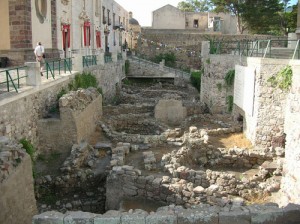 The archaeological deposit down for another four or five feet below the soil huts of the first age of bronze.
The archaeological deposit down for another four or five feet below the soil huts of the first age of bronze.
In the northern part of the excavation are far more substantial than in the south remains dell’Ausonio II represented by a rectangular hut in grandiose rounded corners.
Under the deepening soil excavation has revealed remains of other huts oldest and the middle age of first bronze cultures of Milazzese and “Capo Graziano”. Interesting is the structure of this great hut whose skeleton was carrying timber. A large northern hut and its annexes which develop at the same level are two large cabins of the Ausonio I mentioned that in the foreground is perfectly circular in shape and perhaps covered for a time as a trullo, and is preceded by a head North antrance flanked by a wall straight.
The other, behind it is more oval in shape, more elongated.
It is the clear overlap remains of five different age, Hellenistic, Ausonio II, Ausonio I Milazzese and Capo Graziano.
In the area north of the second Cardo is an interesting hut of the Ausonio I of unusual rectangular shape and slope facing very mutilated remains of huts and the middle and first age of bronze




